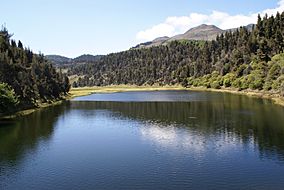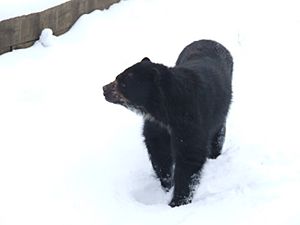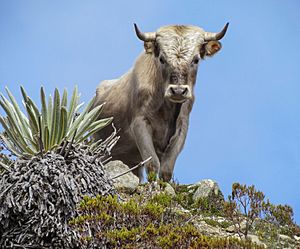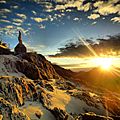Sierra Nevada National Park (Venezuela) facts for kids
Quick facts for kids Sierra Nevada National Park |
|
|---|---|
|
IUCN Category II (National Park)
|
|

Victoria Lagoon
|
|
| Location | Venezuela |
| Nearest city | Mérida |
| Area | 276,446 ha |
| Established | 2 May 1952 |
| Governing body | Instituto Nacional de Parques(INPARQUES) National Park Institute |
The Sierra Nevada National Park (PNSN) is a really important nature park in Venezuela. It's found between the states of Mérida and Barinas in the western part of the country. This park was created on May 2, 1952. President Germán Suárez Flamerich made a special rule to protect the beautiful Sierra Nevada de Mérida mountains in the Andes.
It was the second national park ever created in Venezuela. The first one was Henri Pittier National Park, which was made 15 years before.
The Sierra Nevada is super important for Venezuela's nature. It helps protect the tallest mountain ecosystems in the country. Here you'll find the highest parts of the Venezuelan Andes, including Pico Bolívar. This peak is the highest point in Venezuela, standing at 4,978 m (16,332 ft) tall!
Contents
Park History and Growth
The idea to create the Sierra Nevada Park started back in 1948. Students and teachers at the School of Forest Engineering began pushing for it. The University of the Andes then put together a team to study the idea. They presented their findings to the government to show why the park was needed.
On May 2, 1952, the government board, led by Germán Suárez Flamerich, officially signed a rule. This rule made Sierra Nevada a National Park.
The Sierra Nevada Park is the second oldest National Park in Venezuela. Only Henri Pittier National Park is older.
When it first started, the park was about 190,000 hectares in size. But on August 14, 1985, President Jaime Lusinchi added more land. An extra 86,446 hectares were included. This made the park's total area 276,446 hectares.
Exploring the Park's Geography

The park covers parts of six different areas in Mérida state. It also includes parts of three areas in Barinas state. Its total size is 276,446 hectares. Most of this land, about 185,886 hectares, is in Mérida state. This is about 67.2% of the park. The rest, 90,560 hectares, is in Barinas state, making up 32.8% of the park.
Sierra Nevada is part of the Cordillera de Mérida mountain range in Venezuela's central Andes. This area is very rugged. It has many of the country's highest peaks. These include Pico Bolívar (4,978 m), Pico Humboldt (4,942 m), Pico La Concha (4,922 m), Pico Bonpland (4,883 m), Pico Espejo (4,880 m), Pico León (4,740 m), Pico El Toro (4,729 m), and Pico Mucuñuque (4,609 m).
The Sierra Nevada is separated from another mountain range called Sierra La Culata. The Chama River valley is to the north. To the northeast is the Santo Domingo River valley. This valley stretches from the Kettle Mucubají to the José Antonio Páez dam. In the southwest, the park's border follows the Nuestra Señora River valley. This river flows into the Chama River, downstream from Ejido city.
The park has two main mountain ranges: the Sierra Nevada de Mérida and the Sierra de Santo Domingo. Both are known for their tall peaks, valleys carved by glaciers, and river valleys.
Most of the rivers, like the Chama, Albarregas, and Mucujún, flow into Lake Maracaibo. Other rivers, such as the Caparo, Santo Domingo, and Cajurí, flow into the Orinoco basin. The park also has thirteen river systems. There are ten lakes that were formed by glaciers. Sadly, due to global warming, some of these lakes are getting smaller. Some well-known lakes are Mucubají, La Negra, La Verde, and Los Anteojos.
The plants in the park are typical of Andean cloud forests. These forests have many trees and thick undergrowth. They also have many plants that grow on other plants (epiphytes) and unique species found only here. In higher areas, above 3,000 meters, you'll find special moorland plants. Many of these are species of Espeletia. Drier parts of the Nuestra Señora River Basin have thorny, dry-loving plants. In Barinas, the park is mostly forest with trees up to 25 m (82 ft) tall.
Park Climate and Seasons
The Sierra Nevada has two main seasons each year. There's a rainy season from May to October. Then there's a dry season with less rain from December to March. Besides rain, snow often falls on the highest peaks. Snowfalls are common between July and September. They can happen sometimes during the rest of the year too.
Because the park is in a mountain range, its temperature changes a lot. The average yearly temperature can be 26 °C (79 °F) in the lowest areas (400 m). But it can drop to −5 °C (23 °F) on the highest peaks (over 4,900 m above sea level).
Amazing Animals of the Park
The park's climate helps it be a home for hundreds of animal species. One of the largest animals you can find here is the spectacled bear. This bear is the only type of bear found in the Andes mountains. It is also an endangered species, meaning it's at risk of disappearing forever.
Other wild animals living in the Sierra Nevada include the white-tailed deer and the helmeted curassow. You might also see the puma, the Andean coati, the Andean leopard, and the jaguar. Smaller animals like the paca and the moor rabbit also live here. You might even spot wild cattle and horses roaming freely in the area.
Many birds live in the park too. These include the Andean guan, the white-tailed quetzal, and the masked trogon. You can also find magpies and the black-chested buzzard-eagle. Some very large birds, like the Andean condor, are now in danger of extinction. Because of this, there's a special program in Colombia to help increase their numbers.
How to Visit the Park
The most popular way to get into the park is by using the Mérida cable car. This cable car offers amazing views as it takes you high up the mountains.
Another important way to enter is by road through the village of Tabay. You can go through the La Mucuy area. From there, you can hike into the Sierra Nevada Park. This path takes you past beautiful lagoons like Coromoto, La Verde, and El Suero. You can also walk near Pico Humboldt and La Concha. This area is a base for climbing up to Pico Bolívar from the south. You can even reach Pico Espejo by going southeast.
Images for kids
See also
 In Spanish: Parque nacional Sierra Nevada (Venezuela) para niños
In Spanish: Parque nacional Sierra Nevada (Venezuela) para niños


















